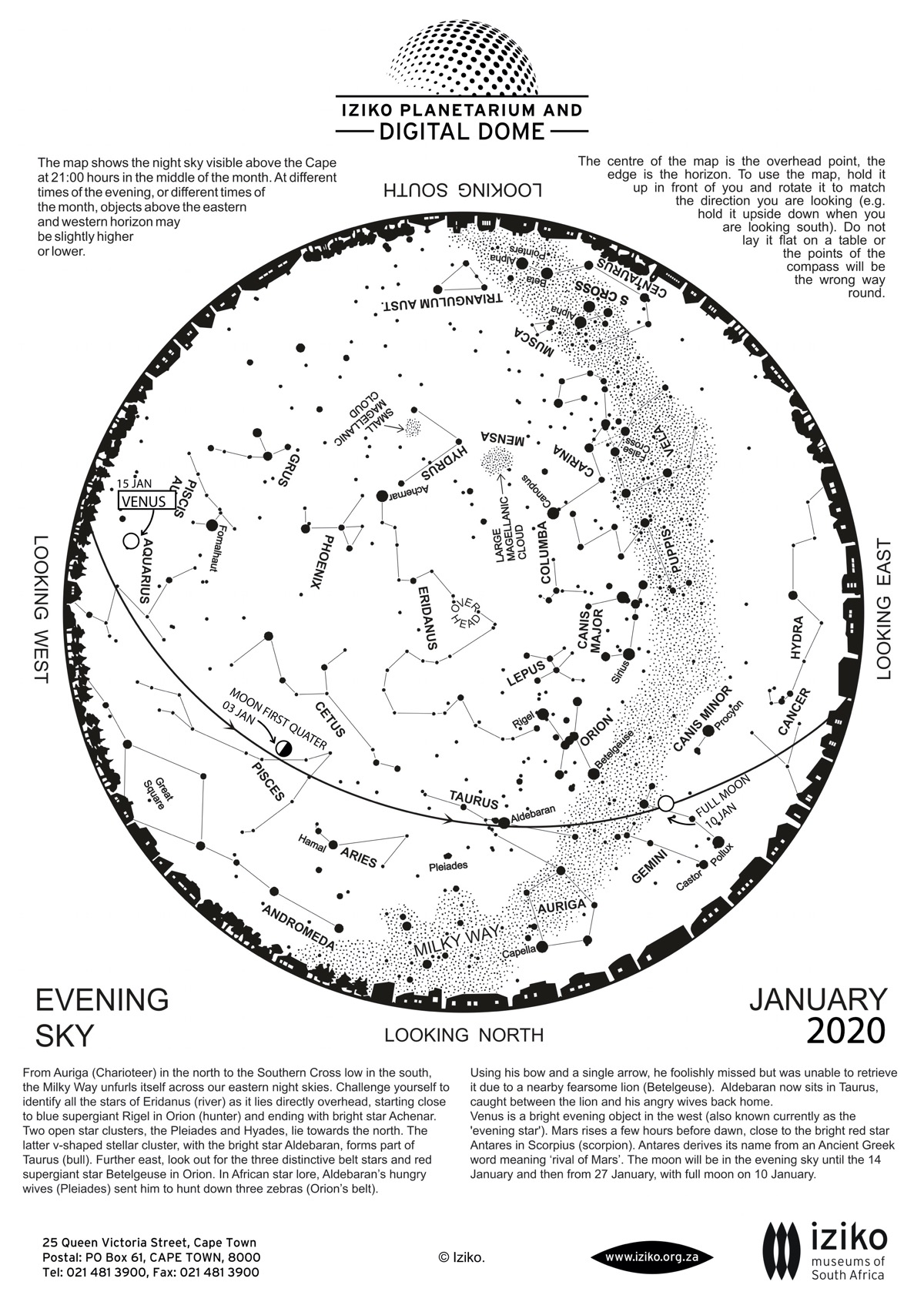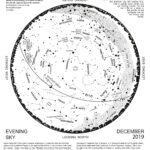
11 Jan Whats Up – January 2020
Sun and Moon
The First Quarter Mon falls on the 3rd of January at 06h45. The Full Moon falls on the 10th of January at 21h21. The Moon will pass through the Earth Shadow on the 10th of January and a penumbral lunar eclipse will be visible from 19h08 until about 23h12, maximum eclipse will occur at about 21h10. The Last Quarter Moon falls on the 17th of January at 14h58 and the New Moon occurs on the 24th of January at 23h42.
On the 13th of January at 22h20, the Moon will be at perigee (closest approach to Earth) at a distance of 365 958km. The Moon will be at apogee (furthest from Earth) at a distance of 405 393 km on the 29th of January at 23h26.
Planetary and Other Events – Morning and Evening
Venus dazzling the evening sky and can be observed near the stars of the constellation Aquarius. This bright planet will be near the crescent Moon on the 27th and 28th of January. Do not miss out on the Venus – Neptune conjunction on the 27th of January. Mercury, the fastest and the smallest planet can be observed at dusk in the last week of January. The Moon will be near Mercury on the 26th and do not miss out on the alignment of the crescent Moon, Mercury and Venus. Mars, the red planet is located near the stars of the constellation, Scorpius. Mars will be near Antares, the red star of Scorpius. Jupiter, the giant planet can be observed at dawn near the stars of the constellation Sagittarius. Jupiter will be near the crescent Moon on the 22nd and 23rd of January. Saturn is caught in the solar glare and therefore not visible this month.
Several meteor showers are active in January. The Puppid-Velids are active from December 5th 2019 to January 7th 2020, peaking on the 29th of December 2019. The alpha Crucids, in the constellation of the Southern Cross (Crux) are active from the 6th January – 28th January, peaking on the 19th. The alpha Centaurids, in the constellation of Centaurus are active from the 28th January to the 21st February, peaking on the 7th of February. They are best viewed between 00:00 AM and 03:30 AM looking towards the constellation of Crux. Hourly rates are expected to be around 5 meteors per hour at the maximum.
The Evening Sky Stars
Low in the north in the evening are the stars variously known as the Seven Sisters, the Pleiades, or IsiLimela. There are six stars in this cluster which are fairly easily visible to the naked eye, and hundreds that can be seen through a telescope. Located about 420 light years away, this is a group of stars which formed from a cloud of interstellar dust and gas about 120 million years ago. The Pleaides stars easily visible to the naked eye are all more than a 100 times as bright as our Sun – our own Sun only looks brighter because it is 27 million times closer to us! Above and to the right of the Pleiades is another cluster of stars called the Hyades, making up the muzzle of Taurus the Bull. The Hyades are about 150 light years away, and about 600 million years old. Bright orange Aldebaran looks as though it ought to be part of this loose group, but is only located in the same direction and, at only 64 light years away, is less than half as distant. It is, however, the most luminous star within a hundred light years of us.
Low on the northern horizon glitters Capella, brightest star in Auriga the Charioteer. As with other bright stars, the effects of atmospheric refraction can cause it to twinkle vigorously when near the horizon, appearing to flash in multiple colours. In July 1951, a pilot in northern Michigan chased Capella for half an hour under the impression that it was a UFO. Given that Capella is 42 light years away, it is not surprising he did not catch it.
High in the NNE are the brilliant stars of Orion, with the twins (Castor and Pollux), lower in the NE. Below Orion in the ENE (below Orion and to the right of the twins) is Procyon, brightest star in Orion’s smaller hunting dog. At only 11 light years away, Procyon is one of our nearest neighbours. Sirius is even nearer, high in the East in January evenings, at only 9 light years distant, and both have dim companions called “white dwarfs”, which are no larger than planets. The diameter of Procyon’s companion is only about 30% larger than the diameter of our Earth, while Procyon’s diameter is millions of kilometres! A white dwarf is a star that has used up its nuclear fuel, and is slowly cooling down until its crystallises, which typically takes billions of years. It still glows, but only with stored energy. Procyon’s companion, for example, is only 0.06% as bright as the Sun.
Canopus, the second brightest star in the Earth’s skies, is a bit SE of the zenith (the point overhead). South of the zenith is Achernar at the Southern end of the Celestial River, while Fomalhaut is the brightest star in the SW. In the southern half of the sky in January there is a curious blend of birds and water creatures (including the Southern Fish, the Crane, The Toucan, The Phoenix, The Peacock, the Bird of Paradise, the Flying Fish, the Swordfish and the Water Snake), mixed with mechanical and scientific constellations such as the Octant, the Pendulum Clock, the Chemical Furnace, the Microscope, the Engraving Tool and the Eyepiece Reticle. The Southern Cross and Pointers are very low in the SW even from the Cape and invisible from northern South Africa.
The Morning Sky Stars
Bright stars in the northern half of the sky include Regulus and Procyon in the northwest, orange Arcturus in the northeast. Blue-white Spica is much higher in the northeast. Spica is the brightest of the stars in Virgo, which represents a goddess of ancient mythology. Which goddess is a bit more mysterious, as some claim she was a goddess of the harvest, others a goddess of justice.
The Cross and the Pointers (the two brightest stars in Centaurus) are high in the south in the predawn January sky, with the three stars of the imaginatively named Southern Triangle directly below the Pointers. The Keel, the Sails, the Poop Deck (constellations seen to the right of the Southern Cross while facing south) were once part of the single giant constellation of Argo Navis, the Argonaut’s Ship that sailed to find the Golden Fleece. Just above the Southern Cross and the Housefly are the stars of the great ship Argo as it sails along the Milky Way, accompanied by the dim stars of the Flying Fish. The Milky Way stretches across the morning sky from east to west, a bit south of the zenith, with the bright stars of the Scorpion now rising in the east before dawn. Look out for the brightest star in Scorpio, Antares (‘rival of Mars’).
Still very high in the January predawn sky is Hydra the Water Monster, with the Cup mounted on its back and the Crow flying nearby. The brightest star in Hydra is Alphard, high in the NW in the January predawn sky. At a distance of 175 light years away, Alphard is a giant star 40 times the diameter of our Sun, and would stretch halfway to the orbit of Mercury if placed where the Sun is. Since Alphard is also 400 times as bright as the sun, we’d be crispy is a jiffy!

